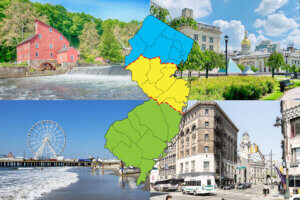In its regular tracking of residents’ satisfaction with life in New Jersey, the Monmouth University Poll finds the current Garden State Quality of Life Index stands at +29. This is down only slightly from the +30 score recorded in December and marks the third highest score in the more than two years Monmouth has been measuring this index.
A major factor in the index score is residents’ overall rating of the state as a place to live. Currently, more than 2-in-3 residents say New Jersey is either an excellent (18%) or good (50%) place to call home, compared to 3-in-10 who rate it as only fair (24%) or poor (7%). This 68% positive rating is down by 4 points from the decade-high 72% recorded in December, just after Superstorm Sandy hit the state.
In terms of the overall index score, the slight statewide rating drop was offset by a 3-point increase in residents’ opinion of their local schools, which now stands at 64% positive. Other components of the index include positive ratings of one’s town as a place to live (73%), local environment (71%), and neighborhood safety (63%). These ratings are no more than one or two percentage points lower than the December poll results.
“While there has been a slight decline in New Jerseyans’ feelings of goodwill about their home state, post-Sandy positivity is still well in evidence,” said Patrick Murray, director of the Monmouth University Polling Institute.
The Garden State Quality of Life Index score remained fairly steady for nearly every demographic group when compared to December’s results. There are only a couple of regional differences worth noting. The index score among residents of the Route 1 Corridor has gone up by 9 points to +35, while the score among Central Hills residents has declined by 10 points to +37. In prior polls, Central Hills residents consistently gave the highest ratings on New Jersey’s quality of life. This group is still numerically highest in the current poll at +37, but they are now closely followed by both Northern Shore (+36) and Route 1 Corridor (+35) residents.
The Garden State Quality of Life Index was created by the Monmouth University Polling Institute to serve as a resident-based indicator of the quality of life offered by the state of New Jersey. The index is based on five separate poll questions: overall opinion of the state as a place to live – which contributes half the index score – and ratings of one’s hometown, the performance of local schools, the quality of the local environment, and feelings of safety in one’s own neighborhood. The index can potentially range from -100 to +100.
|
GARDEN STATE QUALITY OF LIFE INDEX |
|||||||||||
|
|
NJ TOTAL |
GENDER |
AGE |
RACE |
INCOME |
||||||
|
Male |
Female |
18-34 |
35-54 |
55+ |
White |
Black/ Hispanic |
<$50K |
$50-100K |
>$100K |
||
| February 2013 |
+29 |
+28 |
+30 |
+30 |
+27 |
+31 |
+36 |
+12 |
+20 |
+30 |
+36 |
| December 2012 |
+30 |
+31 |
+29 |
+30 |
+30 |
+30 |
+36 |
+14 |
+17 |
+33 |
+38 |
| September 2012 |
+24 |
+28 |
+20 |
+16 |
+21 |
+32 |
+30 |
+5 |
+10 |
+23 |
+37 |
| July 2012 |
+27 |
+26 |
+29 |
+21 |
+31 |
+30 |
+32 |
+16 |
+16 |
+31 |
+37 |
| April 2012 |
+31 |
+33 |
+28 |
+25 |
+30 |
+37 |
+36 |
+19 |
+24 |
+28 |
+42 |
| February 2012 |
+25 |
+20 |
+30 |
+25 |
+24 |
+26 |
+29 |
+13 |
+17 |
+23 |
+38 |
| October 2011 |
+24 |
+24 |
+24 |
+23 |
+21 |
+29 |
+31 |
+7 |
+15 |
+25 |
+31 |
| August 2011 |
+22 |
+25 |
+19 |
+27 |
+19 |
+21 |
+26 |
+9 |
+9 |
+22 |
+32 |
| May 2011 |
+23 |
+24 |
+22 |
+23 |
+22 |
+23 |
+26 |
+14 |
+15 |
+22 |
+32 |
| December 2010 |
+21 |
+20 |
+23 |
+23 |
+20 |
+23 |
+26 |
+13 |
+15 |
+21 |
+31 |
|
GARDEN STATE QUALITY OF LIFE INDEX |
||||||||||
|
|
REGION |
COMMUNITY TYPE |
||||||||
|
North east |
Urban Core |
Route 1 Corridor |
Central Hills |
Northern Shore |
Delaware Valley |
Garden Core |
Urban |
Stable Town |
Growing Suburb |
|
| February 2013 |
+31 |
+17 |
+35 |
+37 |
+36 |
+25 |
+23 |
+11 |
+33 |
+36 |
| December 2012 |
+36 |
+18 |
+26 |
+47 |
+40 |
+21 |
+31 |
+9 |
+37 |
+37 |
| September 2012 |
+29 |
+14 |
+17 |
+45 |
+33 |
+26 |
+13 |
-1 |
+27 |
+31 |
| July 2012 |
+37 |
+12 |
+30 |
+37 |
+34 |
+22 |
+18 |
+8 |
+34 |
+34 |
| April 2012 |
+38 |
+26 |
+27 |
+44 |
+34 |
+22 |
+28 |
+20 |
+35 |
+36 |
| February 2012 |
+33 |
+17 |
+27 |
+35 |
+29 |
+19 |
+22 |
+11 |
+31 |
+29 |
| October 2011 |
+31 |
+6 |
+22 |
+45 |
+35 |
+18 |
+23 |
-1 |
+31 |
+34 |
| August 2011 |
+24 |
+16 |
+21 |
+38 |
+27 |
+26 |
+6 |
+4 |
+29 |
+25 |
| May 2011 |
+28 |
+17 |
+16 |
+41 |
+29 |
+22 |
+20 |
+6 |
+29 |
+28 |
| December 2010 |
+26 |
+15 |
+22 |
+38 |
+23 |
+14 |
+17 |
+12 |
+23 |
+27 |
The latest Monmouth University Poll was conducted by telephone with 803 New Jersey adults from February 6 to February 10, 2013. This sample has a margin of error of ± 3.5 percent. The poll was conducted by the Monmouth University Polling Institute in West Long Branch, New Jersey.
DATA TABLES
The questions referred to in this release are as follows:
(* Some rows may not add to 100% due to rounding.)
- Overall, how would you rate New Jersey as a place to live – excellent, good, only fair, or poor?
| TREND: |
Excellent/ |
Excellent | Good | Only Fair |
Poor | (VOL) Don’t know |
(n) |
| February 2013 | 68% | 18% | 50% | 24% | 7% | 1% | (803) |
| December 2012 | 72% | 20% | 52% | 21% | 5% | 1% | (816) |
| September 2012 | 65% | 15% | 50% | 23% | 11% | 0% | (805) |
| July 2012 | 69% | 17% | 52% | 23% | 8% | 0% | (803) |
| April 2012 | 70% | 20% | 50% | 23% | 7% | 0% | (804) |
| February 2012 | 62% | 15% | 47% | 26% | 11% | 1% | (803) |
| October 2011 | 67% | 15% | 52% | 24% | 8% | 0% | (817) |
| August 2011 | 57% | 14% | 43% | 31% | 11% | 1% | (802) |
| May 2011 | 59% | 14% | 45% | 29% | 11% | 0% | (807) |
| December 2010 | 63% | 17% | 46% | 26% | 10% | 1% | (2864) |
| October 2007 | 63% | 17% | 46% | 25% | 12% | 1% | (1001) |
| August 2004 | 68% | 22% | 46% | 21% | 10% | 1% | (800) |
| May 2003 | 72% | 20% | 52% | 23% | 5% | 0% | (1002) |
| April 2001 | 76% | 23% | 53% | 19% | 4% | 1% | (802) |
| March 2000 | 76% | 25% | 51% | 17% | 6% | 0% | (800) |
| May 1999 | 76% | 22% | 54% | 19% | 5% | 0% | (800) |
| February 1994 | 71% | 18% | 53% | 22% | 7% | 0% | (801) |
| March 1990 | 68% | 21% | 47% | 25% | 6% | 1% | (800) |
| February 1988 | 78% | 27% | 51% | 17% | 4% | 1% | (800) |
| February 1987 | 84% | 31% | 53% | 11% | 4% | 0% | (800) |
| May 1985 | 81% | 29% | 52% | 14% | 3% | 1% | (500) |
| October 1984 | 80% | 29% | 51% | 15% | 4% | 1% | (1000) |
| January 1981 | 66% | 16% | 50% | 26% | 7% | 1% | (1003) |
| July 1980 | 68% | 18% | 50% | 23% | 7% | 2% | (1005) |
- How would you rate your town or city as a place to live – excellent, good, only fair, or poor?
| TREND: |
Excellent/ |
Excellent | Good | Only Fair |
Poor | (VOL) Don’t know |
(n) |
| February 2013 | 73% | 30% | 43% | 20% | 7% | 0% | (803) |
| December 2012 | 74% | 32% | 42% | 17% | 9% | 0% | (816) |
| September 2012 | 72% | 33% | 39% | 19% | 9% | 0% | (805) |
| July 2012 | 74% | 32% | 42% | 18% | 7% | 1% | (803) |
| April 2012 | 76% | 34% | 42% | 17% | 7% | 0% | (804) |
| February 2012 | 74% | 33% | 41% | 21% | 5% | 0% | (803) |
| October 2011 | 73% | 26% | 47% | 20% | 8% | 0% | (817) |
| August 2011 | 76% | 28% | 48% | 18% | 6% | 0% | (802) |
| May 2011 | 73% | 33% | 40% | 20% | 7% | 0% | (807) |
| December 2010 | 73% | 27% | 46% | 20% | 8% | 0% | (2864) |
| May 2003 | 74% | 29% | 45% | 19% | 7% | 0% | (1002) |
| April 2001 | 73% | 28% | 45% | 21% | 6% | 0% | (802) |
| May 1995 | 70% | 30% | 40% | 21% | 8% | 0% | (802) |
| June 1994 | 72% | 31% | 41% | 19% | 9% | 0% | (801) |
| September 1988 | 72% | 26% | 46% | 18% | 9% | 1% | (500) |
| October 1984 | 71% | 30% | 41% | 21% | 7% | 1% | (999) |
| June 1980 | 67% | 23% | 44% | 24% | 9% | 0% | (1005) |
| May 1977 | 66% | 25% | 41% | 24% | 10% | 0% | (1005) |
[QUESTIONS 3, 4 AND 5 WERE ROTATED]
- How would you rate the quality of the environment in the area where you live – excellent, good, only fair, or poor?
| TREND: |
Excellent/ |
Excellent | Good | Only Fair |
Poor | (VOL) Don’t know |
(n) |
| February 2013 | 71% | 26% | 45% | 24% | 4% | 2% | (803) |
| December 2012 | 73% | 25% | 48% | 20% | 7% | 1% | (816) |
| September 2012 | 72% | 30% | 42% | 20% | 7% | 0% | (805) |
| July 2012 | 74% | 30% | 44% | 19% | 7% | 1% | (803) |
| April 2012 | 75% | 30% | 45% | 18% | 6% | 1% | (804) |
| February 2012 | 77% | 29% | 48% | 17% | 5% | 0% | (803) |
| October 2011 | 72% | 25% | 47% | 19% | 9% | 0% | (817) |
| August 2011 | 79% | 31% | 48% | 16% | 5% | 0% | (802) |
| May 2011 | 79% | 33% | 46% | 15% | 6% | 0% | (807) |
| December 2010 | 66% | 14% | 52% | 25% | 9% | 0% | (2864) |
| April 2001 | 70% | 27% | 43% | 22% | 7% | 1% | (402) |
| September 1988 | 53% | 10% | 43% | 31% | 15% | 1% | (500) |
- How would you rate the job your local schools are doing – excellent, good, only fair, or poor?
| TREND: |
Excellent/ |
Excellent | Good | Only Fair |
Poor | (VOL) Don’t know |
(n) |
| February 2013 | 64% | 24% | 40% | 20% | 7% | 9% | (803) |
| December 2012 | 61% | 21% | 40% | 23% | 7% | 9% | (816) |
| September 2012 | 61% | 27% | 34% | 21% | 10% | 8% | (805) |
| July 2012 | 61% | 22% | 39% | 20% | 11% | 8% | (803) |
| April 2012 | 63% | 23% | 40% | 21% | 7% | 8% | (804) |
| February 2012 | 68% | 26% | 42% | 16% | 8% | 8% | (803) |
| October 2011 | 60% | 21% | 39% | 20% | 13% | 7% | (817) |
| August 2011 | 63% | 19% | 44% | 26% | 6% | 5% | (802) |
| May 2011 | 63% | 24% | 39% | 22% | 10% | 6% | (807) |
| December 2010 | 64% | 24% | 40% | 23% | 8% | 5% | (2864) |
| August 2004 | 61% | 24% | 37% | 17% | 12% | 9% | (800) |
| April 2001 | 64% | 21% | 43% | 21% | 6% | 9% | (802) |
| September 1999 | 62% | 18% | 44% | 21% | 9% | 8% | (802) |
| September 1998 | 62% | 20% | 42% | 23% | 9% | 7% | (804) |
| February 1996 | 60% | 20% | 40% | 20% | 11% | 9% | (804) |
| September 1993 | 52% | 16% | 36% | 29% | 14% | 5% | (801) |
| January 1992 | 53% | 15% | 38% | 26% | 15% | 5% | (800) |
| October 1987 | 60% | 14% | 46% | 23% | 6% | 11% | (500) |
| October 1986 | 55% | 15% | 40% | 26% | 10% | 9% | (800) |
| October 1983 | 59% | 16% | 43% | 23% | 10% | 8% | (802) |
| May 1978 | 52% | 12% | 40% | 25% | 12% | 11% | (1003) |
- How safe do you feel in your neighborhood at night – very safe, somewhat safe, or not at all safe?
| TREND: |
Very |
Somewhat safe |
Not at all safe |
(VOL) Don’t know |
(n) |
| February 2013 | 63% | 30% | 6% | 1% | (803) |
| December 2012 | 64% | 29% | 6% | 1% | (816) |
| September 2012 | 65% | 25% | 6% | 0% | (805) |
| July 2012 | 60% | 32% | 7% | 1% | (803) |
| April 2012 | 64% | 31% | 5% | 1% | (804) |
| February 2012 | 62% | 32% | 5% | 0% | (803) |
| October 2011 | 62% | 31% | 7% | 0% | (817) |
| August 2011 | 63% | 31% | 6% | 0% | (802) |
| May 2011 | 68% | 27% | 5% | 0% | (807) |
| December 2010 | 59% | 35% | 6% | 0% | (2864) |
| February 1993 | 42% | 44% | 13% | 0% | (801) |
| October 1987 | 51% | 36% | 11% | 2% | (499) |
| October 1984 | 53% | 36% | 9% | 2% | (500) |
| May 1981 | 43% | 43% | 13% | 1% | (497) |
[Note: All trend results prior to 2005 come from Rutgers University’s Eagleton Poll.]
The Monmouth University Poll was conducted by the Monmouth University Polling Institute from February 6 to 10, 2013 with a statewide random sample of 803 adult residents, including 603 contacted on a landline telephone and 200 on a cell phone. Live interviewing services were provided by Braun Research, Inc. and the telephone sample was obtained from Survey Sampling International. Monmouth is responsible for all aspects of the survey questionnaire design, data weighting and analysis. For results based on the total sample, one can say with 95% confidence that the error attributable to sampling has a maximum margin of plus or minus 3.5 percentage points. Sampling error increases as the sample size decreases, so statements based on various population subgroups, such as separate figures reported by gender or party identification, are subject to more error than are statements based on the total sample. In addition to sampling error, one should bear in mind that question wording and practical difficulties in conducting surveys can introduce error or bias into the findings of opinion polls.
|
POLL DEMOGRAPHICS (weighted) |
|||
| 38% Dem | 49% Male | 28% 18-34 |
63% White |
| 41% Ind | 51% Female | 40% 35-54 |
12% Black |
| 21% Rep | 32% 55+ |
16% Hispanic |
|
|
9% Asian/Other |
|||
Region is defined by county boundaries: Northeast (Bergen, Passaic), Urban Core (Essex, Hudson), Route 1 Corridor (Mercer, Middlesex, Union), Central Hills (Hunterdon, Morris, Somerset), Northern Shore (Monmouth, Ocean), Delaware Valley (Burlington, Camden, Gloucester), and Garden Core (Atlantic, Cape May, Cumberland, Salem, Sussex, Warren).
It is the Monmouth University Polling Institute’s policy to conduct surveys of all adult New Jersey residents, including voters and non-voters, on issues that affect the state. Specific voter surveys are conducted when appropriate during election cycles.
Click on pdf file link below for full methodology and results by key demographic groups.




